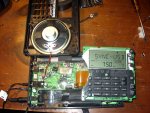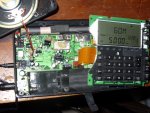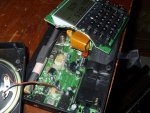I posted this to the G3 group and sent it to the Herculodge blog as well.
My G3 had developed the sync detector issue, as it is from the first run SN#
472. It seemed to work well when I got it, but over time, I guess due to the
component values settling, the sync got worse and worse, and finally settled
into the usual 1 khz low. Since I purchased the unit on eBay, there was no
warranty, and it is the 3rd unit I've had, and I didn't feel like trying to work
something out with Eton. Everything else is great about it, sensitivity and
selectivity, and the MW is clear, strong and as birdy-free as I suppose it can
be. So, surgery time!
Plug in the correct 8v 200ma ac adapter, and take out the batteries. Unit
disassembly is strait forward. 6 screws on the back (the ones with the arrows)
are removed, and one in the battery compartment. DO NOT REMOVE THE ONE THE
SCREW HOLDING THE WHIP ANTENNA!!! Once apart, remove the 7 (I think) screws
holding the button and display board. You'll have to maneuver the halves around
to get to all of the screws, there are wires from the VCO, speaker, and the
whip, and the ribbon cable from the button board is short. Refer to pictures
posted for what final disassembly looks like. I pulled the button matrix out and
fitted it where it would be when the radio is assembled. Tune to a strong
station (I live in the ATL metro, so I used WSB 750) and turn on the sync. Now,
locate c113, a small white variable cap to the left of the ribbon cable, and
turn it until the voices are clear! I would suggest using headphones for this.
Peak using the S-meter, and check both upper and lowers sidebands. Reassemble
the radio.
After the repair, ssb performance is still quite good. ECSS is still possible,
and effective. Nothing else seems to have changed performance-wise. The sync
will occasionally loose the lock and start wailing, but turning off the sync and
turning it back on will correct this. I guess time will tell, but I think this
is it! I'll be watching the group if anyone has questions or comments. I'd
like to hear how this works for others!
My G3 had developed the sync detector issue, as it is from the first run SN#
472. It seemed to work well when I got it, but over time, I guess due to the
component values settling, the sync got worse and worse, and finally settled
into the usual 1 khz low. Since I purchased the unit on eBay, there was no
warranty, and it is the 3rd unit I've had, and I didn't feel like trying to work
something out with Eton. Everything else is great about it, sensitivity and
selectivity, and the MW is clear, strong and as birdy-free as I suppose it can
be. So, surgery time!
Plug in the correct 8v 200ma ac adapter, and take out the batteries. Unit
disassembly is strait forward. 6 screws on the back (the ones with the arrows)
are removed, and one in the battery compartment. DO NOT REMOVE THE ONE THE
SCREW HOLDING THE WHIP ANTENNA!!! Once apart, remove the 7 (I think) screws
holding the button and display board. You'll have to maneuver the halves around
to get to all of the screws, there are wires from the VCO, speaker, and the
whip, and the ribbon cable from the button board is short. Refer to pictures
posted for what final disassembly looks like. I pulled the button matrix out and
fitted it where it would be when the radio is assembled. Tune to a strong
station (I live in the ATL metro, so I used WSB 750) and turn on the sync. Now,
locate c113, a small white variable cap to the left of the ribbon cable, and
turn it until the voices are clear! I would suggest using headphones for this.
Peak using the S-meter, and check both upper and lowers sidebands. Reassemble
the radio.
After the repair, ssb performance is still quite good. ECSS is still possible,
and effective. Nothing else seems to have changed performance-wise. The sync
will occasionally loose the lock and start wailing, but turning off the sync and
turning it back on will correct this. I guess time will tell, but I think this
is it! I'll be watching the group if anyone has questions or comments. I'd
like to hear how this works for others!




